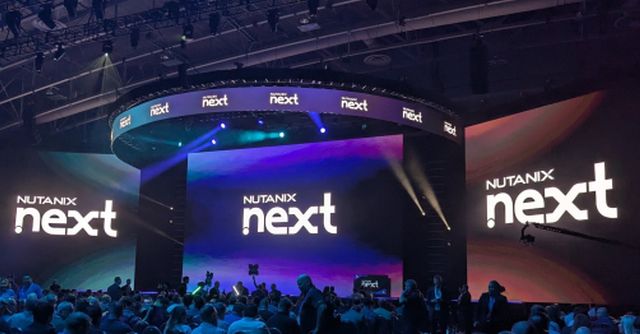
Cloud-native infra anywhere, AI agents, and more from Nutanix .NEXT'25


U.S-headquartered enterprise cloud computing company Nutanix made a slew of announcements focussing on artificial intelligence, Kubernetes innovation and strategic partnerships, aimed at hybrid multi-cloud infrastructure. The announcements made at their annual flagship event - .Next, held in Washington D.C. this year from May 7-9, attracted over 5,000 attendees and showcased the company's ambition to simplify complex IT environments while capitalising on the industry's shift towards autonomous AI and cloud-native adaptability.
Notably, Nutanix has a significant presence in India, with core development centres in Bangalore and Pune. Its business is also experiencing strong growth, potentially exceeding its global projections. Nutanix is seeing a significant growth in India, particularly in sectors such as banking and finance, manufacturing, government and healthcare. CEO Rajiv Ramaswami told TechCircle in an interview that the company's India growth rate is outpacing its global metrics for Annual Recurring Revenue (ARR) and profitability .
Becoming cloud-native and hypervisor-independent
One of the key announcements was the launch of Cloud Native AOS, a hypervisor-free iteration of Nutanix’s core storage software designed to run natively on Kubernetes clusters. The company believes, as data becomes more distributed, users are looking for a consistent way to protect, replicate, and restore data across Kubernetes infrastructure in data centers, bare-metal edge locations and cloud-native hyperscalers. What’s been missing is a common data platform that can run across bare-metal, virtualized, and containerized infrastructure.
Cloud Native AOS completes this puzzle with storage and data services that can run directly on cloud-native infrastructure anywhere, in the cloud or on bare metal. By eliminating the need for a hypervisor, this new solution allows users to consolidate storage management across the distributed hybrid cloud.
Thomas Cornely, Nutanix’s SVP of Product Management said that this solution extends enterprise-grade data resilience—think disaster recovery and seamless migration—to containerised applications across public clouds and bare-metal environments. To put it simply, the new solution reduces the gap in hybrid cloud architectures: consistent data management for stateful Kubernetes workloads.Consequently, the new solution bridges the gap in hybrid cloud architectures by ensuring consistent data management for stateful Kubernetes workloads.
Currently available in early access for AWS, the solution is expected to be generally available by summer (June-August) 2025, with bare-metal support anticipated by the end of the year.
Betting big on agentic AI
At the event, Nutanix AI also announced a major update to its Enterprise AI (NAI) platform, integrating NVIDIA’s NIM inference microservices and NeMo framework.
The company said that the collaboration enables enterprises to deploy agentic workloads across any environment—data centres, public clouds, and the edge—while reducing complexity for enterprise teams deploying generative AI applications.
Debo Dutta, Chief AI Officer of Nutanix, believes that at a time when AI innovation is moving at breakneck speed, new platforms like this can streamline how AI agents are built, run, and managed - alongside while maintaining enterprise-grade security and flexibility.
A shared model service architecture reduces GPU resource strain by allowing multiple applications to reuse centralised LLM endpoints, while built-in guardrails prevent prompt injection attacks. That said, the offering positions Nutanix as a bridge between raw infrastructure and AI orchestration, supporting everything from hyperconverged setups to CNCF-certified Kubernetes distributions.

Strategic global partnership
Nutanix announced a landmark partnership with Pure Storage, by integrating its virtualization platform - AHV hypervisor and Flow networking - with Pure’s high-performance storage systems, now enhanced with native NVMe/TCP support. The new partnership witnesses how companies are responding directly to growing market disruption in the virtualization space with a new integrated solution for virtual workloads that combines Nutanix Cloud Infrastructure with Pure Storage's FlashArray technology. The partnership comes at a time when Gartner projects 70% of enterprise-scale VMware customers will migrate at least half of their virtual workloads by 2028 due to cost concerns following Broadcom's acquisition. The shift creates substantial opportunity for alternative providers.
Meanwhile, the Dell PowerFlex integration reached general availability, allowing Nutanix’s software to manage external storage arrays—a first for the traditionally hyperconverged vendor.
Cisco also joined the aliance with FlashStack for Nutanix, a pre-validated stack combining Cisco UCS servers, Pure Storage arrays and Nutanix’s cloud platform. These alliances reflect a broader strategy to offer customers “choice without compromise,” as Ramaswami said in the keynote on Wednesday.
Nutanix also unveiled the public preview of Nutanix Cloud Clusters (NC2) on Google Cloud, completing its hyperscaler trifecta after AWS and Azure. The offering helps enterprises deploy Nutanix’s stack on Google’s Z3 bare-metal instances, enabling lift-and-shift migrations and consistent operations across clouds.
Focus on security and compliance
In response to the increasing prevalence of cyber threats, Nutanix has broadened its security partnerships to align with the NIST Cybersecurity Framework 2.0. The new integrations with Qualys, Palo Alto Networks, and CrowdStrike are designed to facilitate compliance while strengthening defenses across data, identity, and network layers. These announcements collectively support Nutanix's vision of enabling operations in any environment, the company said.
By introducing cloud-native infrastructure anywhere, adopting AI-driven solutions, and forging strategic partnerships, the company is making a significant investment in hybrid multi-cloud as the standard architecture for enterprises. However, challenges remain, as competitors such as VMware (now part of Broadcom) and Red Hat are intensifying their efforts in the same domain. Besides, economic challenges may hinder cloud migration budgets. However, Ramaswami looks optimistic as he asserts that the company has been adopting a strong partner-centric, modular strategy that allows customers to tailor their solutions, keeping in focus thier budget as well as innovation.
(The author was in the US in an invitation by Nutanix for .Next 2025 event)

